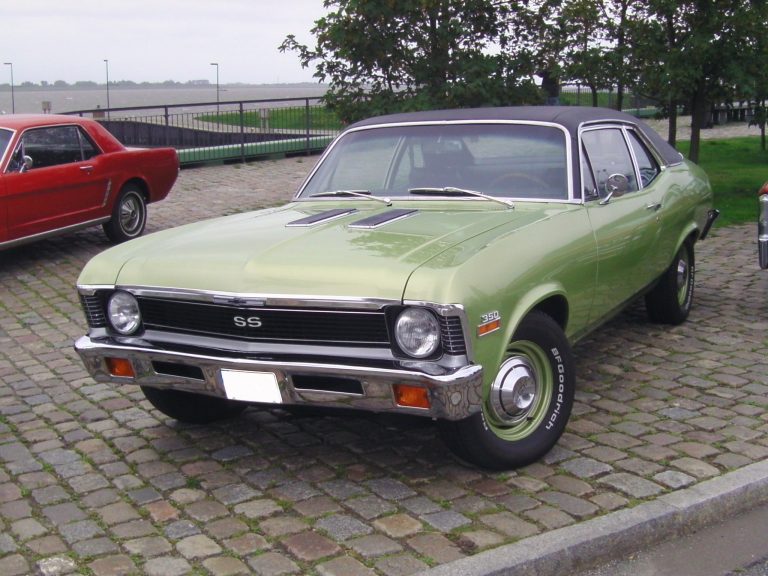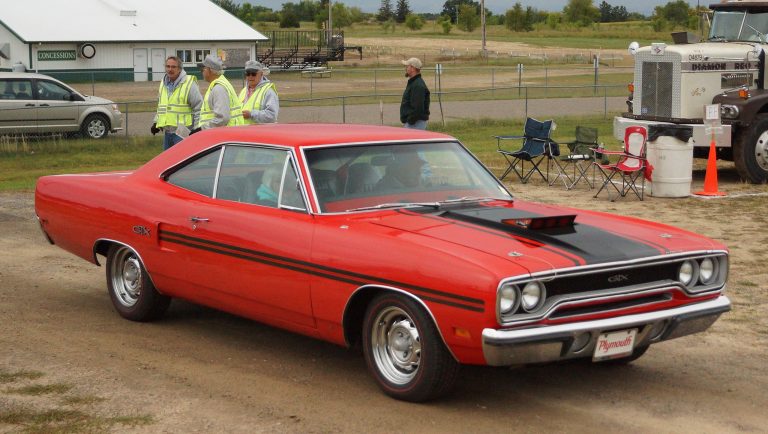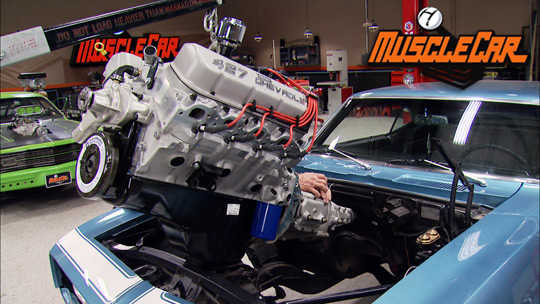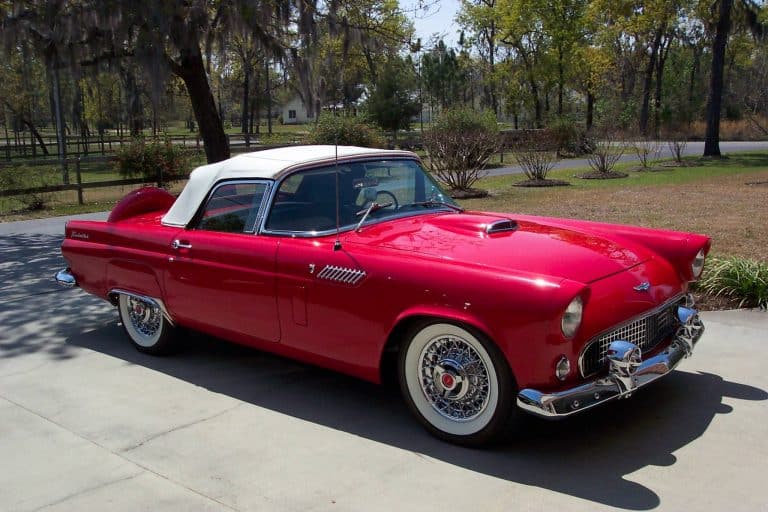Is the Corvette A Muscle Car?

Meet Austin
Austin has been a muscle car enthusiast since an early age with his Dad having a collection including a 1965 Mustang, 1968 Mercury Cougar, and a 1969 Mustang Mach 1 among many others. Austin received a technical writing degree from University of Colorado Denver with the intentions of becoming an automotive journalist. His automotive knowledge, enthusiasm, and hands on experience allow him to craft detailed, accurate, and high-quality articles for the passionate Muscle Car Club audience.
Here’s a scene: You’re walking down the street with a few buddies that say they know their way around an engine when a torch red C7 Corvette steamrolls by with a downshift that breaks the rears loose for a second, just for a bit of fanfare. One of your walking partners says, “I love me a good Corvette, they really sum up American muscle.” Your other automotively-inclined buddy turns and looks at him like he had been momentarily possessed. “What?” says the belittled so-called Corvette-lover on the defense, “Chevy’s the king of muscle, you’re gonna tell me that the Corvette is anything different?” “Yes, yes I am,” says the offended party, “Corvettes don’t have a muscle-y bone in their fiberglass body, except for that 6.2L V8.” Naturally, all eyes shift over to you to settle the score.
The air feels hot and muggy as you stew on the question for a second. Are Corvettes muscle cars? The engine is right but the body is wrong. Does it matter how many doors it has? What would a Corvette be if it isn’t a muscle car? The pressure builds and the heat is on. Your entire reputation is at stake now with your pride and intellect on the line. In a desperate move you yell, “Who gives a damn anyway?” That isn’t what either of them wanted to hear. They could tell that it was a copout and that you are useless as a tiebreaker on the subject. The three of you walk along in defeated silence.
Okay, welcome back. That didn’t actually happen, it was just a hypothetical. But there’s a chance that it could happen and, for that reason, you need to be prepared.
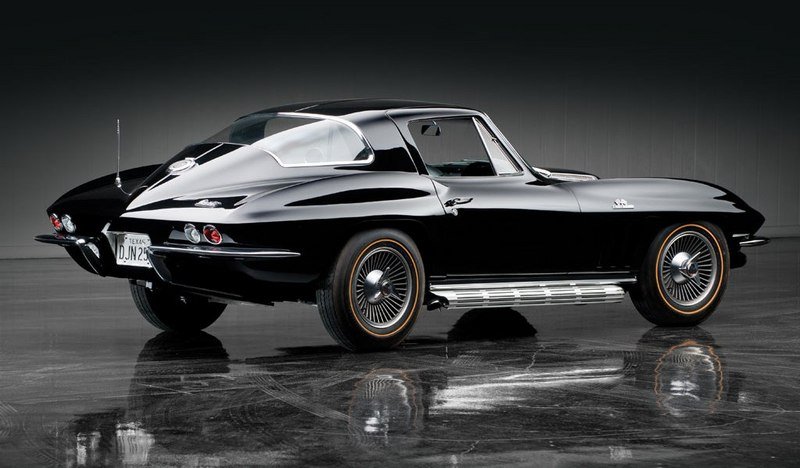
Muscle Car Origins
Quite a few muscle car aficionados claim that muscle cars first originated in the late 1940s. At the time, compression and horsepower figures were generally low despite displacement being comparably high. The Oldsmobile Rocket 88 broke that mold in 1949, equipped with the first high-compression overhead V8 in the GM lineup. What made the Rocket 88 truly special was the combination of the aforementioned V8 and a lightweight body, which it borrowed from the Oldsmobile 76. The V8-lightweight combination was something not seen before the Olds Rocket 88, creating a new class of car, the muscle car.
Fast forward a decade-and-a-half to 1964. The world was a changed place and technology had come a long way. In 1964, Pontiac released the GTO trim for their popular Tempest Le Mans model. The GTO was built on the midsize GM A platform, which distinguished it from most of the larger GM models like the Impala or Bel Air. Like the Rocket 88, the Pontiac GTO features the larger 389 V8 previously reserved for larger models. While it was powerful and light, Pontiac focused very little on precision handling. Most critics at the time lamented the GTO’s slow steering, especially without the power steering option.
Okay, so, looking at the two “pioneer” muscle cars listed above, they share a couple of noteworthy features. Features that would go on to define what a muscle car truly is. Both had a larger-than-normal V8 engine, typically reserved for their respective full-sized brethren. The Rocket 88 and GTO were both built on a mid-size chassis with a focus on keeping things basic, analog, and lightweight. Neither emphasized handling even a little bit, with a larger focus on straight line speed. In essence, those three characteristics would go on to define the term “muscle car.”
Is the Corvette a Muscle Car? – Engine
One of the most important considerations that can make or break a muscle car classification is the engine that powers the car. There’s generally a pretty rigid guideline as far as muscle car engine requirements are concerned. The V8 engine is a staple of the American muscle car and a requirement to be part of the club. As we covered earlier, even the original Oldsmobile Rocket 88 that launched the class was equipped with an overhead valve V8 with a large displacement.
That is actually another important part of the equation as well, displacement. While plenty of consumer models in the 50s, 60s, and 70s were equipped with V8s, that isn’t enough to classify them as muscle cars. The size of the V8 is crucial in determining the classification as well. Most muscle cars, the 1964 Pontiac GTO or 1970 Chevy Chevelle SS, for example, are equipped with the top, or close to top, trim V8 available from the manufacturer at the time. The 1964 Pontiac GTO features the beastly 389cid Trophy-8 V8 producing 348 horsepower in top trim. The 1970 Chevelle SS LS6 utilizes the mighty Chevy 454 V8 capable of 450 horsepower.
Obviously, horsepower continually increases over time as engines get more efficient. For that reason, horsepower figures don’t matter as much as the V8s importance in the lineup.
So, Do Corvettes Fit The Bill In the Engine Department?
Historically speaking, it isn’t the Corvette’s engine that holds it back from a muscle car classification. In fact, Corvettes have been using top trim Chevy V8s for over a half-century. The Corvette has only ever been offered with a non-V8 powertrain for three of its 69 production years, right at the beginning.
Early Corvette Engines
In 1953, the first generation C1 Corvette features a 3.9L Chevy Blue Flame inline-6, which remained the standard engine option until 1956. In 1956, Chevy offered the C1 Corvette with an optional 265cid V8, which outsold the inline-6 exponentially. As V8 power is a pillar of muscle car worthiness, the C1 Corvette, alteast until 1956, cannot be considered a muscle car. That was rectified for the following generations as customer demand for the V8 was so strong.
Since the first generation C1 Corvette, every ‘Vette offered since has been powered by a V8. The C2 Corvette, released in 1963, featured an array of high-horsepower V8 options. The base 327 Chevy V8 was slightly underpowered, which Chevy remedied by offering a Big Block 396 V8 in 1965. The Chevy 427 Big Block made its way into the C2 and C3, truly cementing the mighty V8’s place in the Corvette model.
Corvette V8 Legacy
Following the C2 and C3, the Corvette has used countless Chevy V8s in numerous sizes and configurations. Corvette V8 options have ranged from the C4’s 5.7L L98, which is considered the last of Chevy’s classic small-block V8s, to the 670 horsepower 5.5L LT6 V8 powering the 2023 C8 Corvette Z06.
There have been some standout V8 engines in Corvette history. The modern LS V8 engine series has become one of the most iconic group of engines of all time. When V8s come up in conversation, Chevy LS engines are rarely ever left out. The Gen III/Gen IV Chevy Small-Block retained the pushrod V8 legacy of previous generations while also carrying the formula into the 21st century with modern aluminum construction and electronic fuel injection. The LS1, LS2, LS3, and LS7 are all Corvette staples that range in displacement from 5.7L to 7.0L. There are plenty of other important Chevy V8s that have powered the Corvette over the years. All of which are enough to satisfy the muscle car requirement. With that being said, there’s more to muscle cars than just their engine.
Is the Corvette a Muscle Car? – Body
So, with the engine classifier out of the way, we move on to the Corvette body and chassis. While Corvette engine options have changed a fair bit over the years, their basic chassis construction has stayed pretty similar. Since their inception, Corvettes have featured a composite-material body. Even in 1953, when composite materials were still in their infancy, the Corvette featured a fiberglass body. Chevrolet’s vision, from the very beginning, was to maximize the Corvette’s power-to-weight ratio while maintaining a high level of rigidity and keeping costs low. That is exactly what composite construction achieved.
The C3 Corvette is the first to be constructed using a press mold process. In that process, fiberglass and resin are pressed into a mold to form a solid body panel. Chevy ditched that process in 1973, when they adopted a sheet-molded composite process. The SMC process creates composite material that is stronger and more rigid and allows for other materials to be integrated. Every Corvette since Chevy switched the process has featured SMC body panels. The bodies of modern Corvettes feature even lighter and stronger polymer compounds and even carbon fiber in some cases.
Additionally, the Corvette’s body design, especially considering the C2 chassis and beyond, is heavily concerned with aerodynamic efficiency. While the C1 ‘Vette was designed in a time not as concerned with drag coefficients, it is still more slippery than most other cars of the era. As the Corvette continued to evolve, aerodynamics became increasingly more important to the Corvette’s identity and performance. It’s no surprise that the most current C8 Corvette has the lowers drag coefficient of them all.
What Does All of That Mean From a Muscle Car Perspective?
Compared to the standard muscle car formula, the Corvette has always been more forward-thinking in terms of body construction. The space-age body material and specialized construction also bumped up the price. Let’s compare the ‘Vette and the Chevy Nova SS, for example. The Nova SS falls firmly in the muscle car camp. It fulfills the engine requirement with a 396 Big-Block V8 under the hood (on 1968-1970 models), but it also fulfills the requirement of having a mid-size, no-nonsense frame. The Nova SS wasn’t built with space-age composites. It’s good-ol’ sheet metal. The tried and true material construction kept the Nova’s price low without any fancy frills.
Compared to the Corvette, the Nova was designed with little regard for aerodynamic efficiency. As the Nova was designed as an economical compact car to compete with the Ford Falcon. As such, a slippery, streamlined body was firmly out of consideration. In fact, the bare-bones, no-nonsense styling and construction are two major reasons that the Nova is considered a muscle car and the Corvette isn’t.
Due to the fact that the Corvette features a unique, highly specialized and aerodynamic body, it can’t be considered a muscle car in that respect. Muscle cars aren’t supposed to be highly technical, they’re supposed to be basic. For that reason, the Corvette misses the mark on this metric.
Is the Corvette a Muscle Car? – Chassis/Handling
Another factor in the “Is a Corvette a muscle car” conundrum is the chassis/handling characteristics that the Corvette embodies. As we already established in the section above, the Corvette is built on a highly specialized platform. The Corvette features certain performance-enhancing components that aren’t found on other GM or Chevy models. In fact, before the C4 Corvette which was built on the GM Y-body platform, the Corvette featured an entirely unique body-on-frame construction.
Looking at the GM Y-body platform a bit closer, it is clear that it diverges away from a traditional muscle car setup. The GM Y-body that 1984-present Corvettes are built on is the second generation of Y-body chassis. The original GM Y-body platform was introduced in 1960 and served as the basis for cars like the Pontiac GTO. While the Y-body platform has muscle car roots, the second generation Y-body splits from that. For example, the Gen II Y-body platform, and the Corvette, as a result, has 4-wheel independent suspension. That obviously points to a focus on Corvette handling and cornering performance.
Corvette Handling Improvements
Unlike other cars that fall in the muscle car category, the Corvette has been focused on nimble handling characteristics from the very beginning. The C2 Corvette introduced independent suspension to the line, while most muscle cars lacked it. The C4 Corvette built on that even further, implementing aluminum brake calipers and all-aluminum suspension components. That not only reduced weight overall but decreased rotational weight for better cornering performance.
Further handling improvements came with the C5 Corvette, including active handling and a 50/50 weight distribution. The C5 chassis used reinforced rails and hydroformed sections which simplified the structure and eliminated weight. The innovations continued to transpire into the following generations too. The C6 Z06 is the first ‘Vette to have an all-aluminum chassis. All of this to say, the Corvette breaks an important, if largely unspoken rule when it comes to muscle cars: it can actually handle decently.
That isn’t to say that all muscle cars have to handle poorly. The Oldsmobile Cutlass 442, for example, left the showroom with disc brakes and coilover suspension, making it nimble. However, the Corvette took handling and cornering performance to a different level. One that separates it from the muscle car class. Features like independent suspension, aluminum suspension components, and 50/50 weight distribution are very non-muscle. Therefore, the Corvette fails in that respect too.
So, If A Corvette Isn’t a Muscle Car, What Is It?
At this point, we’ve made a pretty substantial argument that the Chevy Corvette isn’t a muscle car. While it might have a beefy V8 engine to support muscle car claims, everything else is wrong. The Corvette’s body and chassis are too modern and space age for a muscle car classification. It isn’t a derivative of an earlier, civilian-focused model. They aren’t basic and analog. And, as a final note, they handle too well. So, if a Corvette isn’t a muscle car, what is it?
Well, looking at all of the evidence that we’ve collected, the answer is pretty clear. The Chevy Corvette is a sports car, plain and simple. In the previous sections, specifically the ones concerning the chassis and handling, the issue isn’t that the Corvette doesn’t do things well enough to be a muscle car, its that it does them too well. The overall mantra of the muscle car is cheap power in a straight line. While the Corvette certainly has power, it isn’t cheap by muscle car standards and it can do more than go in a straight line. Corvettes are too refined to be considered muscle cars. The lightweight nature and performance handling put it in a class above.
In fact, the Corvette has been trapped in the sports car category since its inception until very recently. The ‘Vette isn’t a slouch when it comes to performance driving, that’s a fact. However, it has been missing some of the advanced technology that has kept it from competing with Ferrari or Porsche. However, with the new 2023 C8 Z06, the Corvette has broken that mold. With a 670 horsepower mid-mounted V8 and a modern dual-clutch transmission, the Corvette is a supercar now.
Is the Corvette a Muscle Car Summary
Speaking bluntly, no Corvettes aren’t muscle cars. While the Chevy Corvette is a high-horsepower American car, it doesn’t meet the other requirements to be a muscle car. That mainly boils down to the Corvette being too performance-oriented. The muscle car formula is rather specific and is based on a few key requirements. First, a muscle car needs to have a high-performance V8 engine. The Chevy Corvette has historically checked that box.
Muscle cars have to be cheap and have an overall pedestrian construction. This is where the Corvette leans more towards sports car territory. Since its inception, the Corvette has been constructed from a composite material, making it extremely light. Most muscle cars have a steel body, similar to the consumer model that they are based on. Since the Corvette is so highly specialized, it falls into the sports car category.
The Corvette is also extremely capable around corners, as Chevy prioritized handling with the ‘Vette. While bad handling isn’t a necessary quality for a muscle car, traditional muscle cars weren’t explicitly designed to handle well. The extra emphasis on the Corvette’s handling and unique chassis bump it up to a class above.
While the Corvette might not be a muscle car, that doesn’t subtract from its overall badassery. In terms of sports cars, and American sports cars more specifically, it is hard to think of a better option than a Corvette. With all of this knowledge under your belt, you should have no trouble correcting your misinformed friend. The Corvette isn’t a muscle car, it’s a sports car.

